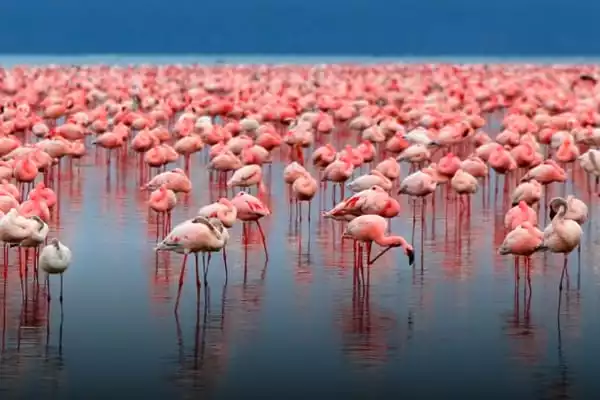When it comes to warning of a hidden cost of green technologies, flamingos may act as a canary in the coal mine. Mining for lithium appears to be a major threat to the iconic pink birds, which rely on ecologically vulnerable salt flats bordering the high Andes Mountains. Researchers reveal in the Proceedings of the Royal Society B that mining for the metal and climate change are causing the decline of two flamingo species found only on Andean plateaus.
Lithium, which is used in lightweight, rechargeable batteries for electric automobiles, smartphones, and other goods, is projected to play a significant role in assisting in the fight against climate change. Global demand for the metal is expected to treble over the next decade or so. The new finding highlights that the quest for lithium is not without drawbacks, fitting into a growing body of research revealing lithium mining’s adverse impacts on ecosystems.
One of the world’s greatest lithium resources encompasses parts of Chile, Bolivia, and Argentina, an area known colloquially as the “lithium triangle.” The region also has the Atacama Desert plateau, one of the driest regions on the planet, as well as a number of shallow, salt flat lake habitats that rely on a restricted water supply. These ecologically delicate “salares” feed cyanobacteria and diatom algae, which are then devoured by three different varieties of flamingos, accounting for half of the world’s flamingo species.
It’s a genuine conundrum because no one is going to argue that climate change isn’t a monster we have to deal with. Finding ways to lower those environmental costs, he argues, could be a good first step, particularly by making lithium mining more water efficient or enhancing the capacity to recover lithium from spent batteries.
Nathan Senner
This fragile ecosystem is now in an existential conflict because lithium refinement ponds and other industrial mining processes use a massive amount of water — an estimated 400,000 liters per ton of lithium, says Nathan Senner, a population ecologist at the University of South Carolina in Columbia.
And there’s only so much water to go around. “This is literally the driest desert in the world,” Senner says. “Much of that [mining] water has to come from groundwater.”
Senner, along with ecologist Jorge Gutiérrez of the University of Extremadura in Spain and bird ecologist Juan Navedo of the Austral University of Chile in Valdivia and others, compiled data from flamingo surveys dating back over 30 years. The researchers also looked at satellite footage that tracked changes in water surface area in five salt flats in Chile’s side of the lithium triangle. In addition, the scientists used satellite data to measure cyanobacteria levels as well as environmental elements that could influence the salt flats’ water levels, such as precipitation and temperature.
Senner and his colleagues discovered that the surface area of the five salares has fallen by at least 30% since 1984, owing in part to increasing evaporation, which is controlled by environmental conditions such as wind, humidity, and temperature. The researchers also discovered that water levels vary greatly between years. And such oscillations appear to have a substantial influence on the number of flamingos in a particular year by regulating the availability of food for the birds.
Flamingo populations “may fluctuate by literally thousands of individuals in just a couple of years,” according to Senner.

According to the study, the long-term drying trend caused by climate change, which may diminish the general availability of food for flamingos, is being compounded by ever-increasing lithium mining. And it’s having an effect on two flamingo species: the Andean (Phoenicoparrus andinus) and James’ (Phoenicoparrus jamesi) flamingos, whose populations in Chile’s Salar de Atacama have fallen 12 percent and 10%, respectively, over the last 11 years. Hundreds of birds have died as a result of this.
This drop, according to the study, is directly related to lithium mining. As the Salar’s mining ponds expanded, nearby James’ and Andean flamingo populations declined in lockstep. Water loss from new mining operations could be a significant contributor. Groundwater pumping for lithium production grew from zero to 1.8 cubic meters per second between 1986 and 2018. At the same time, the Salar loses around five football fields’ worth of surface area per year.
Though the decreases did not occur throughout the region, the findings are particularly troubling for these two species because they do not exist anywhere else on the planet. “They’re completely devoted to these saline lakes,” Senner explains.
Flamingo decreases and salar drying might have a knock-on effect on people, as popular flamingo-based ecotourism in the region would likely suffer, according to the study. “Science-based conservation management principles may still allow for the future preservation of some major hypersaline systems in the region,” says Mattia Sacc, an ecologist at Curtin University in Perth, Australia, who was not involved in the study.
As the demand for lithium increases for use in technology like as electric vehicles, the threat to flamingos may worsen.
“It’s a genuine conundrum because no one is going to argue that climate change isn’t a monster we have to deal with,” Senner says. Nonetheless, as this study demonstrates, the technologies that could aid humanity in combating climate change may have their own set of severe environmental consequences. Senner believes that being aware of the repercussions will be critical in assessing the costs and advantages of such solutions.
Finding ways to lower those environmental costs, he argues, could be a good first step, particularly by making lithium mining more water efficient or enhancing the capacity to recover lithium from spent batteries.





